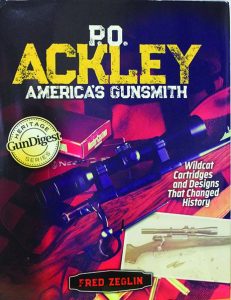Review by
Dave Workman | Senior Editor
 P.O. ACKLEY – AMERICA’S GUNSMITH, by Fred Zeglin. ©2017. Gun Digest Books, Krause Publications, Iola, WI. 252 pages, hardcover. Price $59.99
P.O. ACKLEY – AMERICA’S GUNSMITH, by Fred Zeglin. ©2017. Gun Digest Books, Krause Publications, Iola, WI. 252 pages, hardcover. Price $59.99
From the opening pages of P.O. Ackley – America’s Gunsmith, it is obvious that author Fred Zeglin invested a considerable amount of energy and spent perhaps years researching this project.
It’s an interesting read, particularly for anyone who has toyed with the idea of “wildcat” cartridge development, for which the late Parker O. Ackley became famous. He was, indeed, “America’s gunsmith,” a writer for Shooting Times and Guns & Ammo, and one of the top custom gun makers in the country.
This book is not just about firearms and sizzling cartridges developed by Ackley; it’s also biographical with details about his life that not many people might know. His ancestors came to the New World in the mid-1600s, as detailed in the first chapter. He lived during a period that saw tremendous development of new rifle calibers and considerable growth in the reloading field.
As the book details, Ackley wasn’t just a “wildcatter,” he was an extraordinary gunsmith, responsible for both cartridge and rifle development. It is his place in history to have cartridges dubbed “Ackley Improved,” which translates to what Philip Massaro, writing in the Foreword, calls “a cartridge that has been maximized.”
There is no doubt that Ackley got the most out of every cartridge he developed, or shall we say, “Improved.”
While this may not mean much to casual gun owners, to the experienced marksman/hunter, these improvements have delivered the goods in terms of trophies and meat in the cooler.
One interesting thing about Ackley is that he spent time at the Ogden Arsenal during WWII, the same period when another firearms legend named Elmer Keith was there.
This book is nicely illustrated, complete with diagrams of Ackley’s various cartridges and images that nicely support the story. There are discussions about rifle barrels, stocks, actions, scope mounts and head spacing; things that matter to technical shooters who will probably delight in this volume.
There is an added treat at the rear of this book. Zeglin offers several pages of reloading data for Ackley cartridges. This is not Ackley’s data, but information that the author explains was “compiled from modern sources that have gone to the trouble to pressure test the data.”
This chapter also offers safety tips for cartridge reloaders.
Ackley passed away in August 1989, but his legacy will live on for generations of devoted shooters and hunters.



